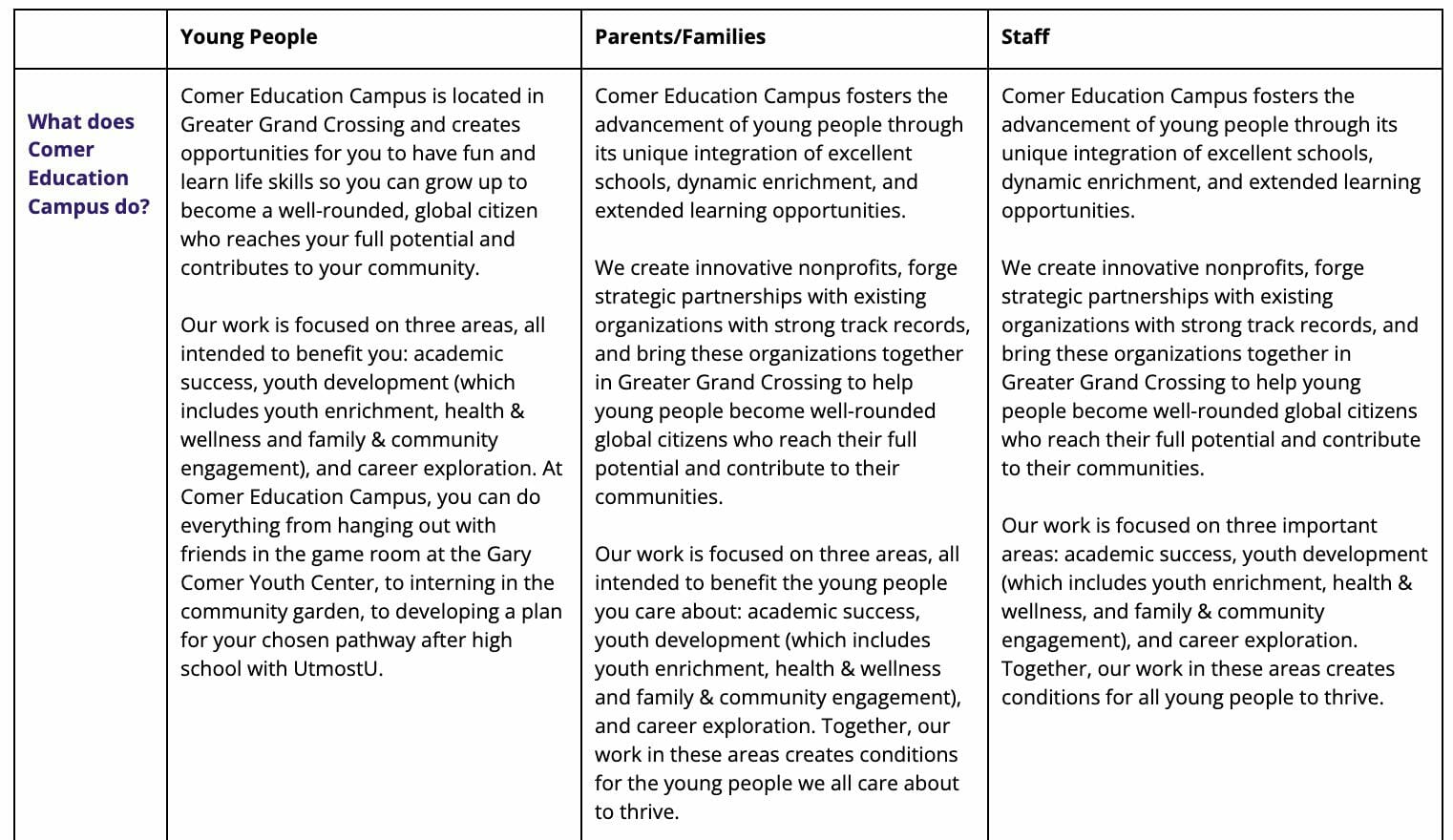Developing messaging for your nonprofit can be complex because of the diverse stakeholders your organization needs to reach, from the individuals you serve, to your funders, board members and community partners.
Each is motivated and engaged by a slightly different message, or requires different information from your organization.
Regardless of who you’re communicating to, you need all of your messaging to feel consistent, cohesive and strength-based, so those impacted by your work feel proud of their association to your organization and your funders and supporters are motivated to uplift your mission.
We’ve developed a messaging process that puts your stakeholders at the center, while allowing you to tailor your messaging to each of your nonprofit’s unique audiences.
Start with the development of overarching nonprofit key messages
To ground communications in consistency, always start by developing a set of overarching key messages for your organization.
These messages should expound on your nonprofit’s vision and mission to articulate the ideal future your organization exists to create, and explain how your organization is uniquely positioned to advance your mission.
When we work with clients, we usually start with the development of a reason for being statement, which is a statement that describes the organization’s unique impact, an impact that no other nonprofit can make in quite the same way. For example:
Our network exists to provide transformative experiences, through and inspired by camp, to children around the world living with serious illnesses. This is accomplished by the collaboration of our independently operated partners and programs. Together we:
- Serve children living with serious illness and their family members from more than 50 countries across 4 continents, always free of charge
- Share knowledge, resources, and responsibility for ensuring the highest quality and safest camp experiences
- Bring our medical and programmatic expertise to support children with a complex range of medical conditions
This statement should not only identify your nonprofit’s unique positioning, but also align stakeholders around your purpose and impact, and the central messages that need to be communicated. With a reason for being statement in place, you can go on to develop messaging about:
- Who your nonprofit serves
- Where you serve them
- What you do, your programs and services
- Why you do the work you do
This overarching messaging serves as the basis or foundation of your nonprofit’s communications and can be used on your website, in fundraising materials, grant proposals and other collateral materials.
But how do you modify messaging for each of your audiences, while maintaining message cohesion and consistency?
Understand the unique needs of each one of your nonprofit’s stakeholder audiences
While overarching key messages help those within your organization get on the same page about how you communicate about the work you do, you still need to evolve messaging for each one of your stakeholder groups. The best way to do this is by directly involving your audiences in shaping both your overarching key messages and key messages by stakeholder group. This means using surveys, interviews and focus groups to understand the perspectives of your organization’s most important stakeholders, and leveraging those insights to build or evolve effective messaging.
At Prosper Strategies, we use the Shared Power StrategyTM philosophy to help organizations better understand the needs, preferences and lived experiences of their stakeholders. This is particularly important when it comes to the development of key messages for two reasons:
- The first is to understand which messages are most resonant with each one of your nonprofit’s audiences and what will motivate them to stay connected to your mission.
- The second is to ensure messaging represents your work and those you serve in a way that is true and empowering to them. This should be true of ALL of your messaging, regardless of the stakeholder group to which you’re communicating.
With stakeholder insights in hand, your nonprofit can start to modify your overarching key messages to focus on what each stakeholder group is most interested in learning about from your organization. For example, in your donor communications, you may focus more on your local community impact, while to your program participants you might highlight the services you offer, and with your foundation funders you might highlight your efforts to dismantle systemic barriers.
Remember, your messaging changes for each stakeholder group to emphasize different aspects of your work, but should always make those you exist to serve feel good about their association with your mission. When creating marketing and fundraising collateral, you’ll reference these messages based on the audience your organization is targeting with the communication.

Nonprofit messaging example by stakeholder group
Continue to re-evaluate and evolve your nonprofit’s messaging
Like any important strategy your organization develops, your key messaging strategy should always be evolving based on real-world circumstances. We recommend revisiting key messagings every six months to a year or whenever there are changes within your organization. Most importantly, ensure your messaging is always reflective of the preferences of the individuals and communities you serve.
Are you ready to articulate your messaging succinctly, consistently and in a strength-based way? We’d love to hear from you!